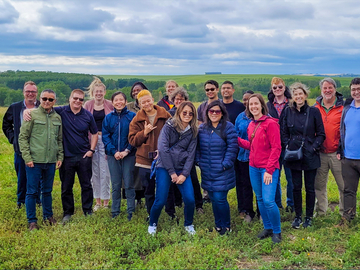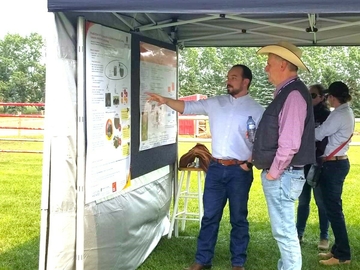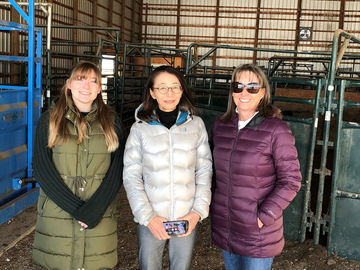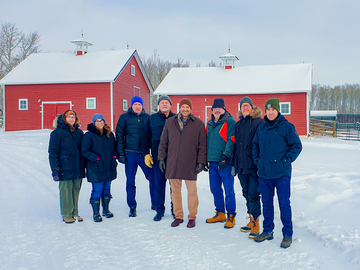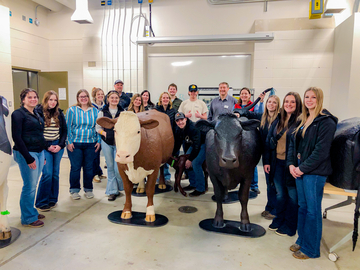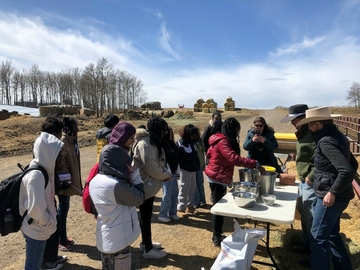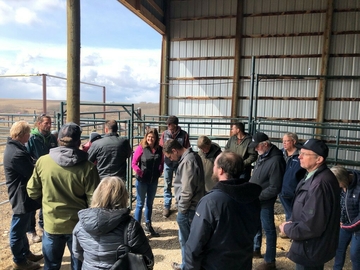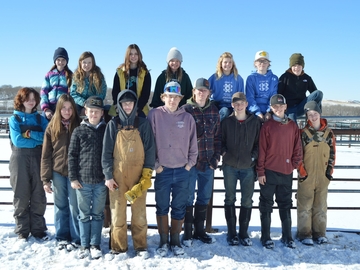Spring 2024 Newsletter
Welcome to the Spring 2024 issue of the W.A. Ranches newsletter. We’re excited to share what’s been happening at the Ranch this past year, and the great things we’ve been able to achieve with the gift of this incredible resource from the Anderson-Chisholm family to the University of Calgary.
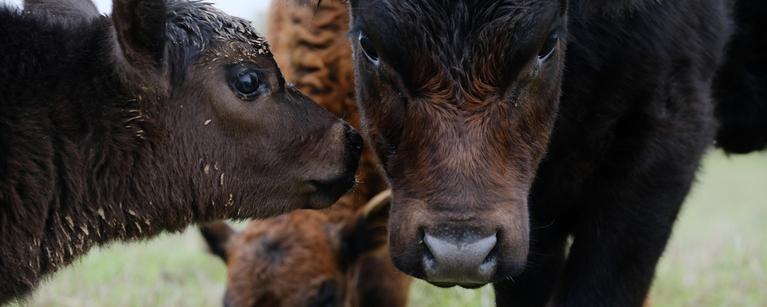
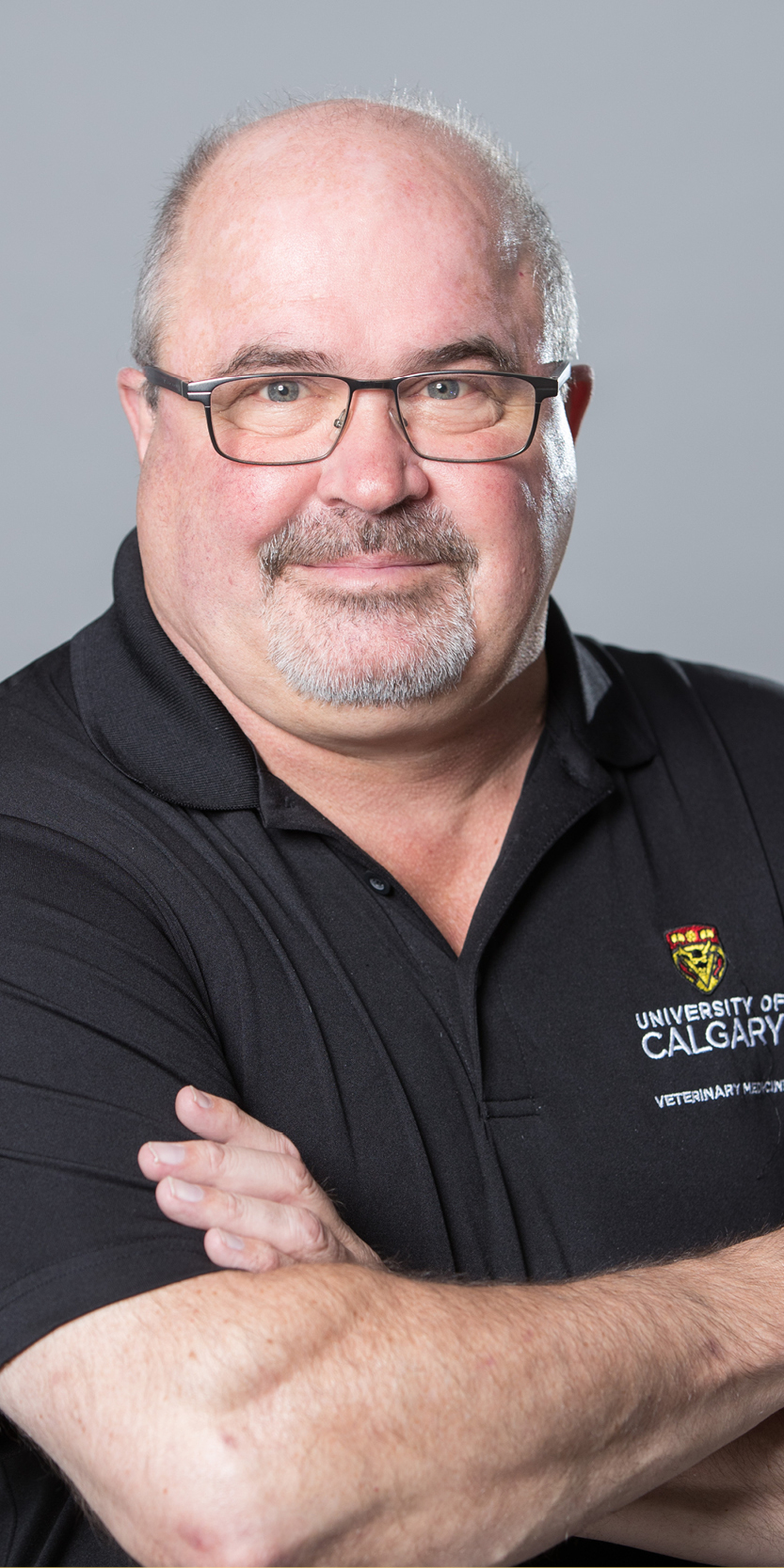
Message from the Director
Greetings from W.A. Ranches at the University of Calgary. I am thrilled to share with you our 2023-2024 annual newsletter. There are a number of things happening at W.A. which include teaching, research, outreach and youth programming activities within a working commercial cow-calf operation.
Contained within these pages are research updates, milestones, improvements and achievements. Researchers have provided updates on previous projects or have described new projects involving W.A. In terms of research, we have included an article on a new major initiative on Agrivoltaics, a process that combines solar energy production with agriculture, in our case cattle grazing.
It is hard to believe but December 2023 marked the 5th anniversary of the donation of W.A. Ranches and is one of the highlights in the newsletter. We have included information on student achievements over the past five years. A sincere thank-you to Jack Anderson and Wynne Chisholm for this much appreciated transformational gift.
Although Covid had an impact, we are increasing activities every month, as visible in the photos on the final pages which highlight ranch visits by various groups and our youth activities.
As I mentioned in last year’s newsletter, the provincially funded expansion of the University of Calgary Faculty of Veterinary Medicine to 100 students provided funds to improve teaching facilities at W.A. Ranches. I am thrilled to report that we now have temporary portables at our Cochrane North location.
Finally, I would like to thank those that contributed content, organized, and produced this newsletter. These things do not happen by themselves, and your efforts are appreciated.
Dr. Ed Pajor, Ph.D.
Director, W.A. Ranches at the
University of Calgary
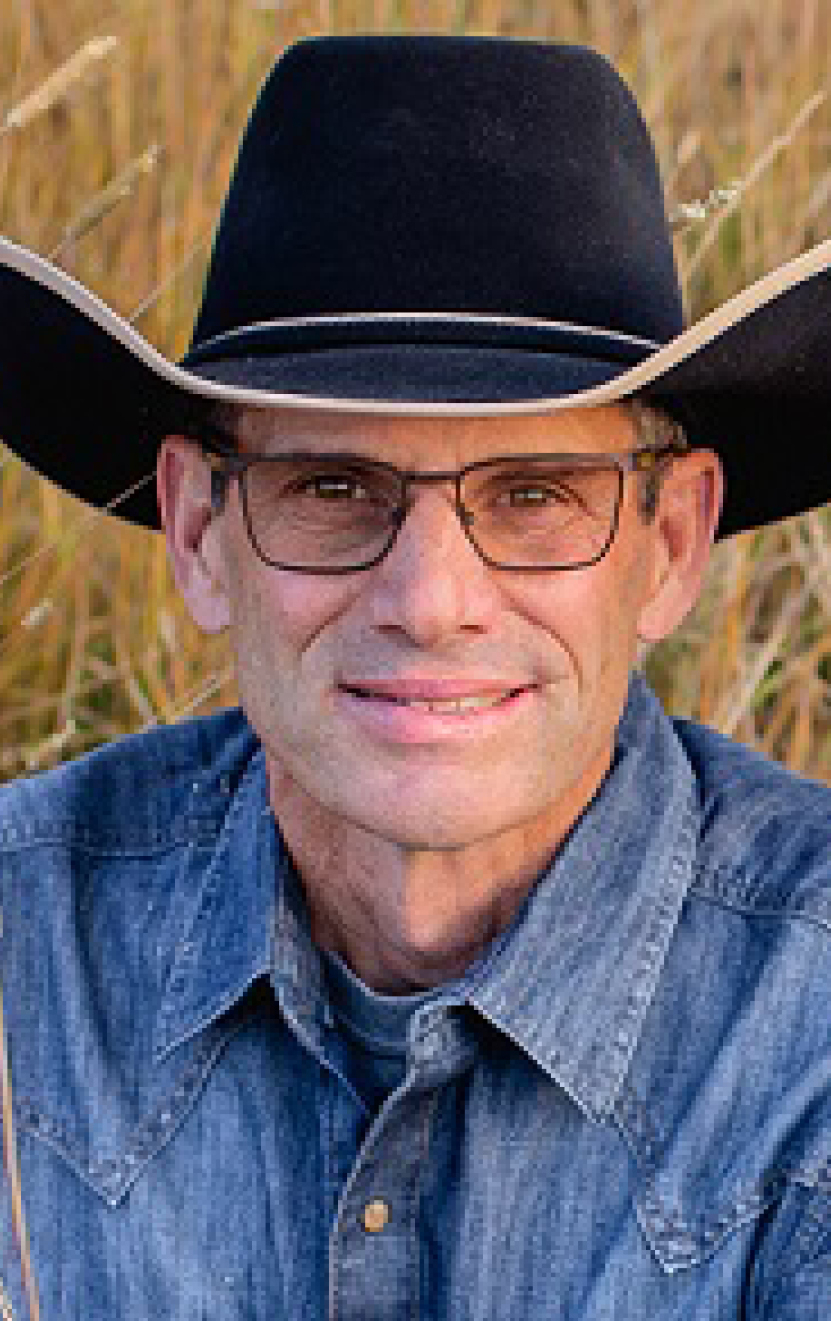
Message from the Manager
Howdy all from W.A. Ranches!
Just another day on the W.A., which means it might be regular ranch work, being involved with teaching future veterinarians, or helping out with research projects to benefit the beef industry. Everyday is a new adventure!
We were lucky to see that our fall gather was timed with record high cattle prices. However, it’s an unfair game in this business when cattle prices are high and mother nature leaves you dry. With the ongoing drought the ranch still managed to put up enough feed, but we desperately need moisture. Luckily, we built a new water storage cistern that has helped get us through last year’s drought.
Highlights at the ranch include an excellent calving season, high percentage of calves weaned and the addition of DNA collection on the entire herd and following our calf crop thru to harvest. We are very excited about using the data collected to inform our management practices. We are looking forward to the 2024 calving season, which will have likely started when you are reading this newsletter. Thanks once again to the full time and part time crew for their hard work and dedication to W.A. Ranches.
Jonny Bennett
Ranch Manager, W.A. Ranches at the
University of Calgary
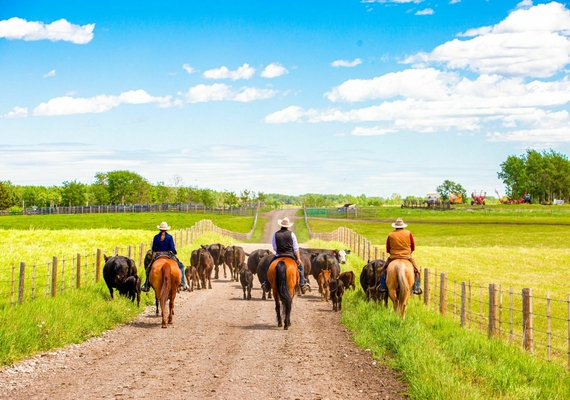
How to donate a cattle ranch — and what to do with it when you get it
5 years in, W.A. Ranches is transforming agriculture education and research at UCalgary
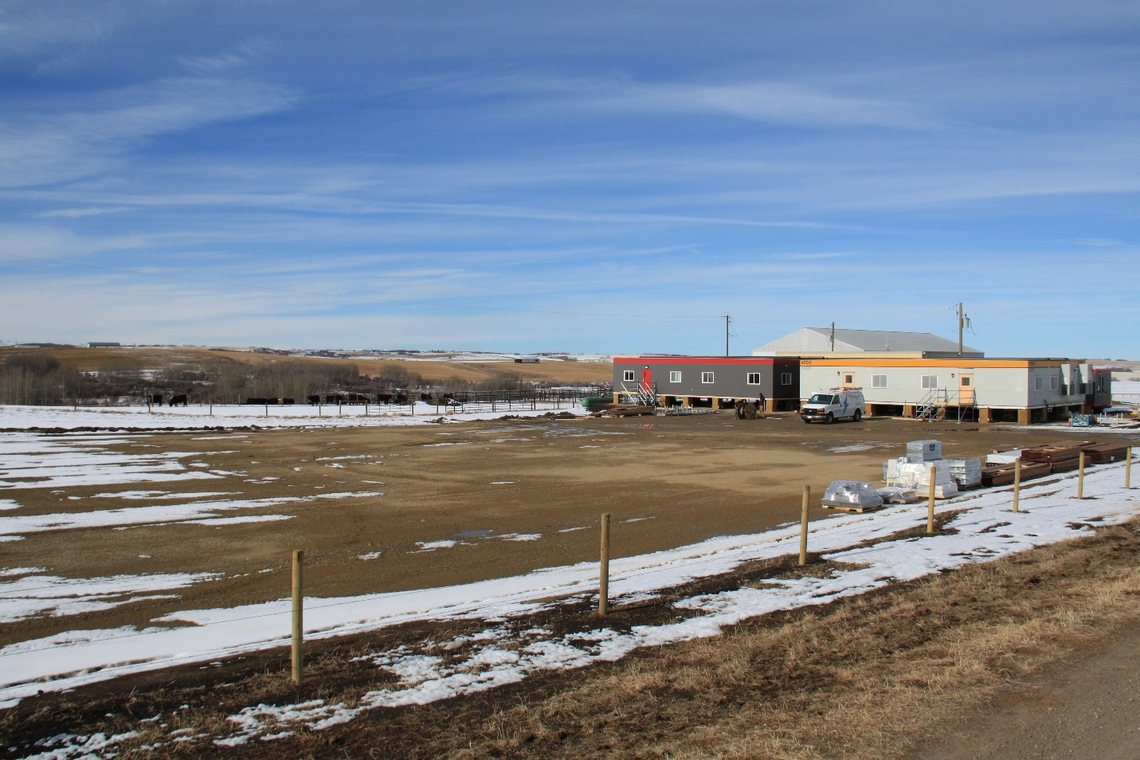
Temporary Teaching Portables in Action at W.A. Ranches
UCVM is thrilled that the temporary teaching portables and retrofitting of the cattle handling system at the Cochrane North location at W.A. Ranches has been completed enough that classes are now using the facilities. VM405 used the Cochrane North facility to pregnancy check animals and the Cochrane East facility to collect and evaluate semen samples from bulls. Additional semen analysis was done at the Cochrane North portable. The readiness of these facilities is making a meaningful difference in delivering quality programming at a working ranch, despite variable weather, for our UCVM students.
VM305 recently had the opportunity to vaccinate cattle and learn low stress handling practices. Students’ comments included that “This is the best lab we have had all year” and “When can we come out to W.A. again?”.
Dr. Maria Camila Ceballos commented that the animals used for the low stress handling lab were excellent to work with, and that the facilities and layout for the low stress handling lab were excellent. It is anticipated that all construction will be completed by the end of May 2024.
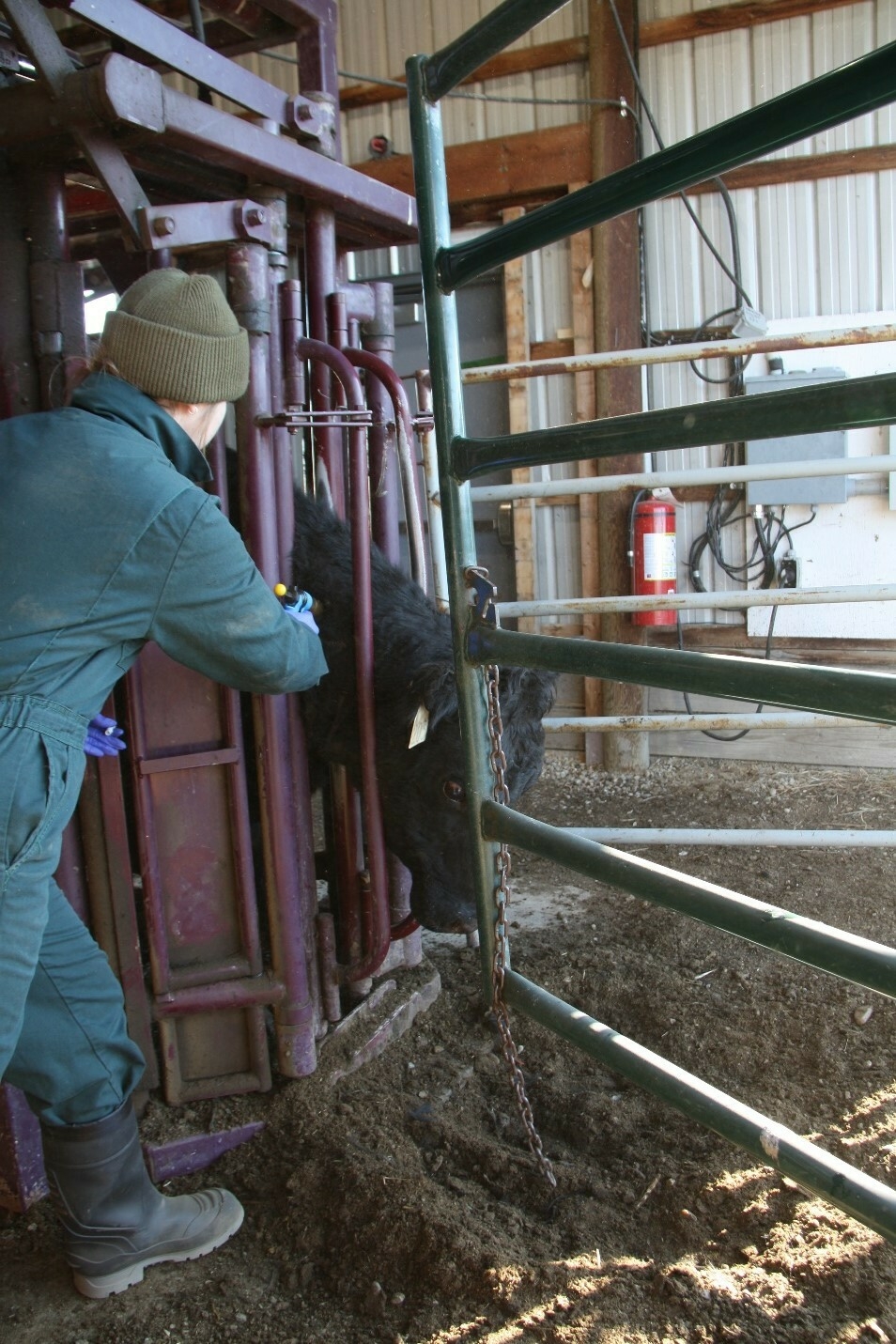
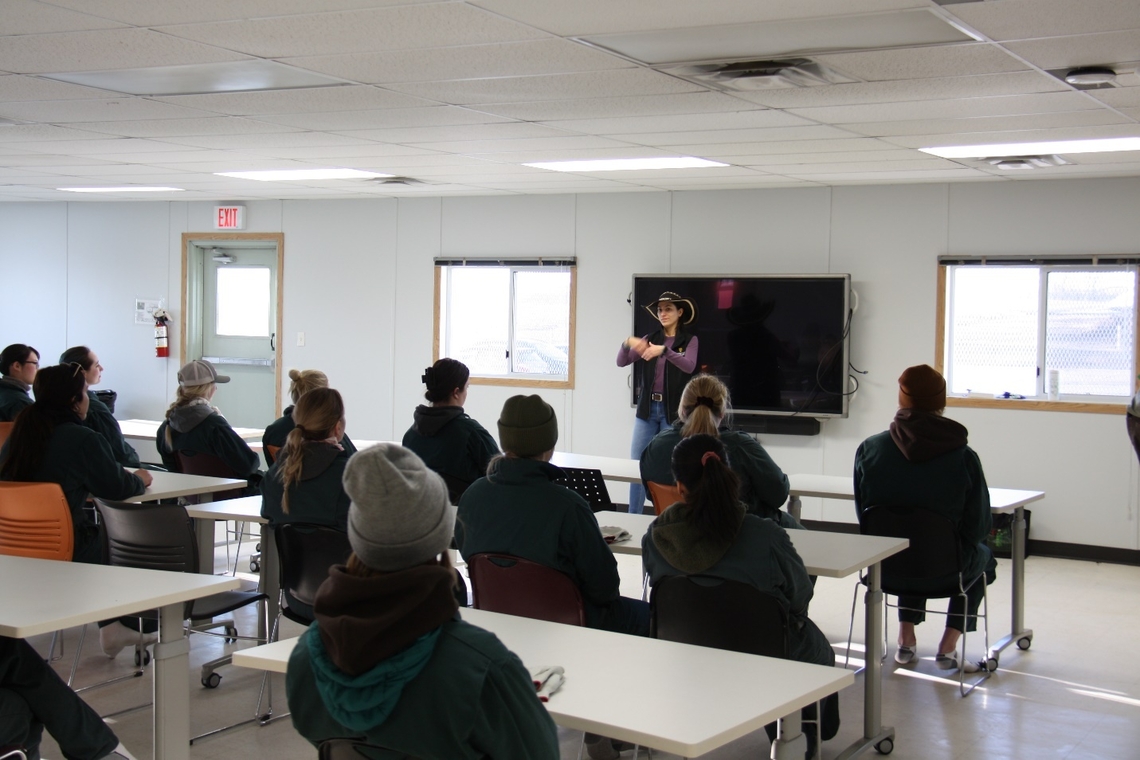
Moo-ve on over, there’s an exciting new solar project in town
Agrivoltaics project receives $3M from Emissions Reduction Alberta, paving the way for solar energy generation alongside cattle farming
A transformative collaboration between local Solartility Inc. and the University of Calgary is poised to redefine the intersection of agriculture and renewable energy.
This partnership, facilitated through the Industry Engagement team in the Office of the Vice-President (Research) at UCalgary, has been awarded $3.1M by Emissions Reduction Alberta (ERA), and was announced by the Government of Alberta on Dec. 6.
The project is a step towards renewable energy adoption in Alberta, culminating in the establishment of an agrivoltaics research facility. The collaboration brought together researchers from the Faculty of Veterinary Medicine and the Faculty of Science, as well as from the Schulich School of Engineering, fostering a transdisciplinary approach to the agrivoltaics model.
What is agrivoltaics?
“Agrivoltaics is the simultaneous use of areas of land for both agricultural production and solar energy generation,” explains Dr. Ed Pajor, professor in the Faculty of Veterinary Medicine and director of W.A. Ranches.
“It is being used with various types of crop production and to a limited extent with sheep and dairy cattle. Very little research has occurred using agrivoltaics on cattle ranches.”
Agrivoltaics initiatives have the flexibility to arrange solar panels in different configurations tailored to the requirements of the animals or crops intended to coexist with the solar installation. In the context of this project, the panels will be positioned in vertical rows, ensuring ample space between the rows to facilitate grazing for cattle. This practice is called solar grazing.
Cultivating collaboration: project beginnings
Solartility, a Calgary-based renewable energy utility provider, had an ambitious goal of seamlessly integrating solar energy generation with cattle farming, addressing the challenge of land competition between food and renewable energy production.
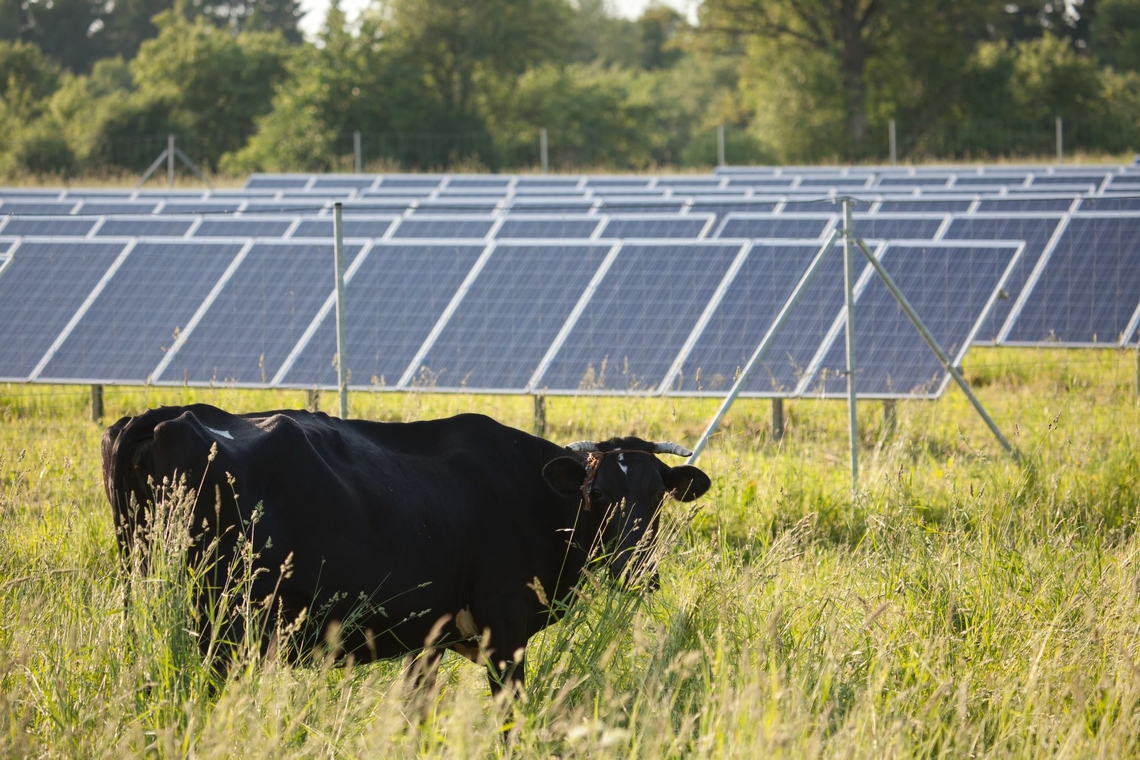
“By bringing the expertise and resources of this innovative company together with our scholars, we will advance agrivoltaics in our province in a way that we could not do independently,” shares Carmen Rieder, Manager, Industry Engagement (Research). “We look forward to a mutually beneficial research partnership with Solartility for many years to come.”
This laid the groundwork for a transdisciplinary research endeavor with academics from UCalgary, with the ultimate goal to build an agrivoltaics research facility at W.A. Ranches. The 19,000-acre ranch in the foothills of Alberta was generously donated to UCalgary in 2018 for the purposes of teaching and learning, research, and community engagement. This act of philanthropy provides the canvas upon which researchers will conduct long-term veterinary, ecological, and environmental monitoring studies.
Understanding bull behavior to increase reproductive success and identify health issues
Vinicius Camargo, Ed Pajor, and Jennifer Pearson
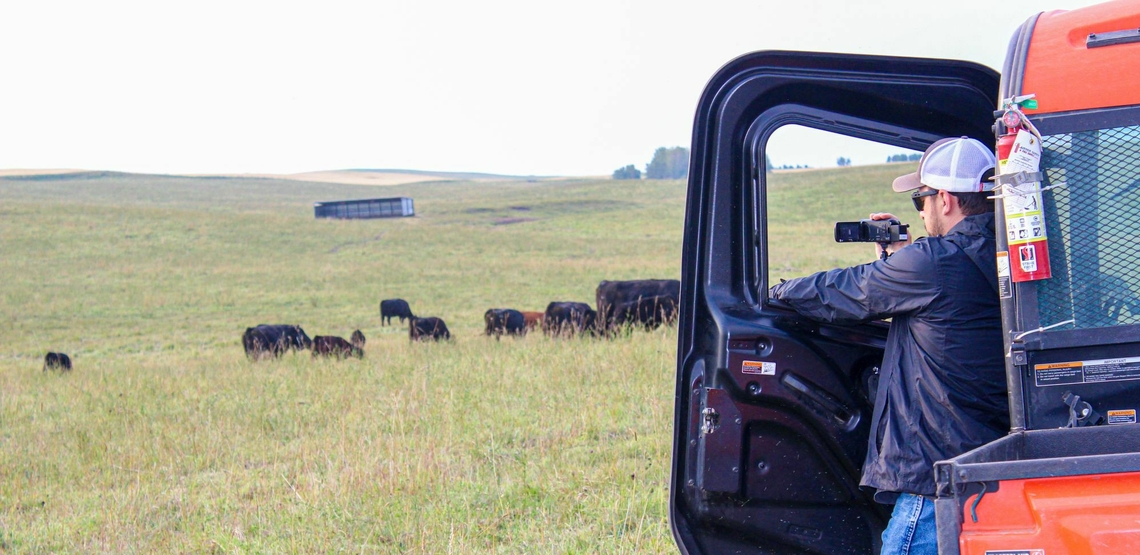
Why do some bulls have higher reproductive success than others? Can injured bulls be identified early using remote monitoring technologies? The answers to these questions lie in bulls’ behavior, and Dr. Vin Camargo (Ph.D. candidate) and his supervisors, Drs Jennifer Pearson and Ed Pajor, are trying to address these issues.
Last summer, they placed collars with GPS, accelerometer, and proximity sensors in 12 bulls and proximity tags in 115 cows at the W.A. Ranches to track them throughout the breeding season. These bulls were closely monitored by video to identify signs of injuries. With this technology, they investigate different aspects of bull behavior that will be used to understand its relationship with the DNA parentage results.
Furthermore, the data from the collars will be compared to the videos to determine how early the injured bulls can be identified. In the past year, the team developed an artificial intelligence algorithm tailored to identify beef bulls’ behavior, which has been used to process the collar data in addition to other techniques.
With this project, they expect to identify the best technology for bulls’ health monitoring and to understand key characteristics of high and low-siring capacity bulls that have the potential to help producers select bulls and form breeding groups.
Tactile stimulation and umbilical antiseptics’ impact on pre-weaned calf welfare
Victor Brusin, Claire Windeyer, and Maria Camila Ceballos
Have you ever thought about the impact early interactions and care can have on cattle welfare? As stewards of these animals, it is important to understand how handling practices influence their behaviour, health, and growth. But why does this matter? A significant factor influencing animal welfare is the human-animal relationship. The quality of interactions between humans and cattle can influence this relationship. Positive interactions, characterized by gentle handling, attention to cues, and respect for the animal’s natural behaviours, can reduce stress levels and foster trust. Conversely, negative interactions or neglect can lead to heightened stress, fear, and even injury. Recognizing the importance of a positive human-animal relationship is paramount for promoting animal welfare. By nurturing a respectful and trusting relationship with cattle, we promote their welfare and contribute to their overall health and growth. Understanding and prioritizing human-animal relationships allows us to refine handling practices, ultimately ensuring livestock welfare and productivity.
That is what my project delves into – exploring how two different management strategies early in beef calves’ lives influence human-animal relationships, growth and health of weaned calves. We investigated the effects of two management interventions – tactile stimulation and umbilical antiseptic – on calves’ welfare. Over 120 calves, spanning both genders, were divided into four groups: TSUA) calves with tactile stimulation and application of umbilical antiseptic; TS) calves with tactile stimulation but no application of umbilical antiseptic; UA) calves without tactile stimulation but with application of umbilical antiseptic, and C) control calves without tactile stimulation or application of umbilical antiseptic; applied early in their lives.
Our measurements covered various welfare indicators: behaviour (using four different indicators), health (evaluating the risk of getting treated), and productivity (average daily weight gain).
Our results demonstrated, under the conditions in which this study was performed, that while one of the behavioural indicators evaluated (flight speed) suggested that tactile stimulation can potentially reduce calves’ reactivity at weaning, no impacts on health and productivity were observed. Our study marks a pioneering effort in western Canada, shedding light on the intricate dynamics between human interaction, early care, and calf welfare. It evidences our commitment to continuously investigating strategies to improve animals’ lives and our relationship with them based on knowledge. It is important to remember that every interaction with cattle on the farm has an impact.

Investigating mismothering in beef cattle
Emma Roux and Ed Pajor
Mismothering, a major concern for beef producers, occurs when a cow fails to bond with her calf. A survey revealed 56% of western Canadian farms experience it, leading to dam culling (61.5%). Mismothering manifests as aggressive rejection (causing injury/death), lack of care, or adoption of the wrong calf. This harms calf survival by reducing immunity transfer, nutrition, and predator protection. Additionally, culling mismothering cows and resolving the issue incur high economic costs.
Despite its prevalence, mismothering remains poorly understood. Current interventions (isolation, restraint, oxytocin) lack scientific backing. Potential causes lie in cow and calf factors, external elements (other cattle, humans, weather) and calving environment characteristics. Furthermore, different “styles” of mismothering, likely due to various factors, haven’t been described.
This study addresses these gaps by defining different mismothering styles and identifying risk factors. Data from 56 mismothering pairs (2023 calving season, 2 ranches) was collected. Isolated and video-recorded, these pairs were observed until bonding or calf fostering. Cow, calf, and environment details were noted, including breed, parity, body condition, udder/teat scores, calving ease, calf sex/weight, twinning status, calving temperature/weather, and pasture density.
Preliminary results revealed diverse behaviors:
- Avoidance (70%): Cows avoid their calf, potentially leading to abandonment or neglect (no licking after birth).
- Nursing rejection (20%): Cows reject nursing attempts (kicking, head-butting).
- Undue aggression (9%): Cows display unprovoked aggression towards their calf.
Heifers were the majority of mismothers (64%). Notably, 61% had poorly shaped teats despite moderate/optimum body condition. Interestingly, 55% of mismothered calves were female.
Further data collection (2024 calving season) aims to investigate the impact of calving ease, weather, temperature, and pasture density on mismothering.
This study’s final results will provide detailed descriptions of mismothering styles with their associated risk factors. This knowledge will be crucial for designing effective prevention strategies and determining the best management interventions for different mismothering situations.
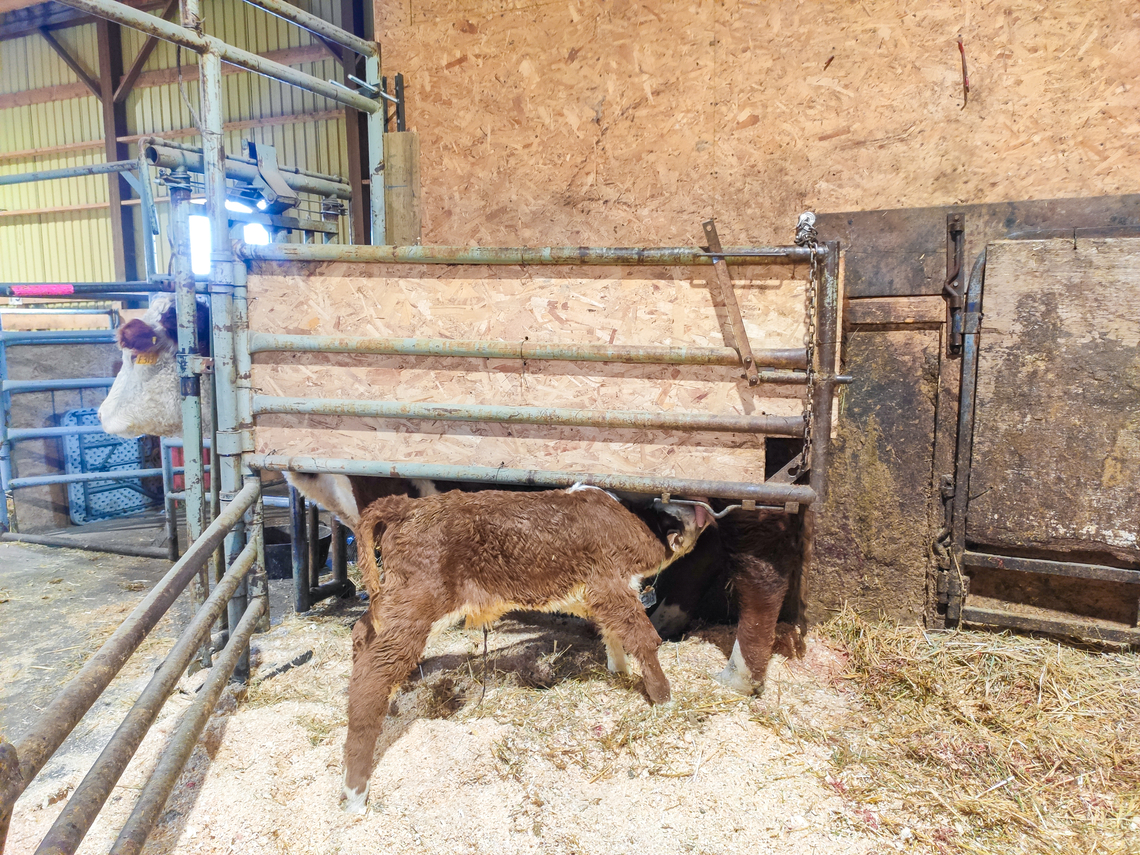
Health and welfare impacts of different weaning methods on dams
Sanjaya Mijar and Karin Orsel
While many weaning studies have focused on the impact of calf health, we followed up with a study that focused on the dam’s experiences. In fall 2022, we conducted a study measuring the different levels of stress experienced by dams following abrupt, fence line, or nose-flap weaning methods. We weaned a total of 30 cow-calf pairs using one of these weaning methods, and we observed and measured behaviours such as eating, ruminating, walking, pacing, lying, and vocalizing. Additionally, we collected fecal and saliva samples to measure cortisol levels as indicators of stress.
Nose-flap weaned cows vocalized and walked less, with no pacing compared to the other weaning methods. Although abruptly weaned cows had a high vocalization, walking and activity, and pacing one day after their calves were separated, these behaviours normalized the following day. On the other hand, fence line weaned cows continuously showed these behaviours throughout the weaning period. CowManager tag data showed reduced eating and ruminating time by fence line weaned cows after weaning, which was supported by visual observations (for eating).
Nose-flap weaned cows also had lower cortisol levels throughout the weaning period, although we did not find any difference in cortisol levels in abruptly and fence line weaned cows before and after weaning.
Interpreting behaviours such as vocalization, activity, and pacing as vivid responses to stress by weaned cows, we concluded that nose-flap weaning seemed the least stressful method, while fence line weaning appeared the most stressful weaning method for beef cows. These findings hope to raise awareness among ranchers and provide insights into the implications of weaning stress on dam welfare and behaviour.
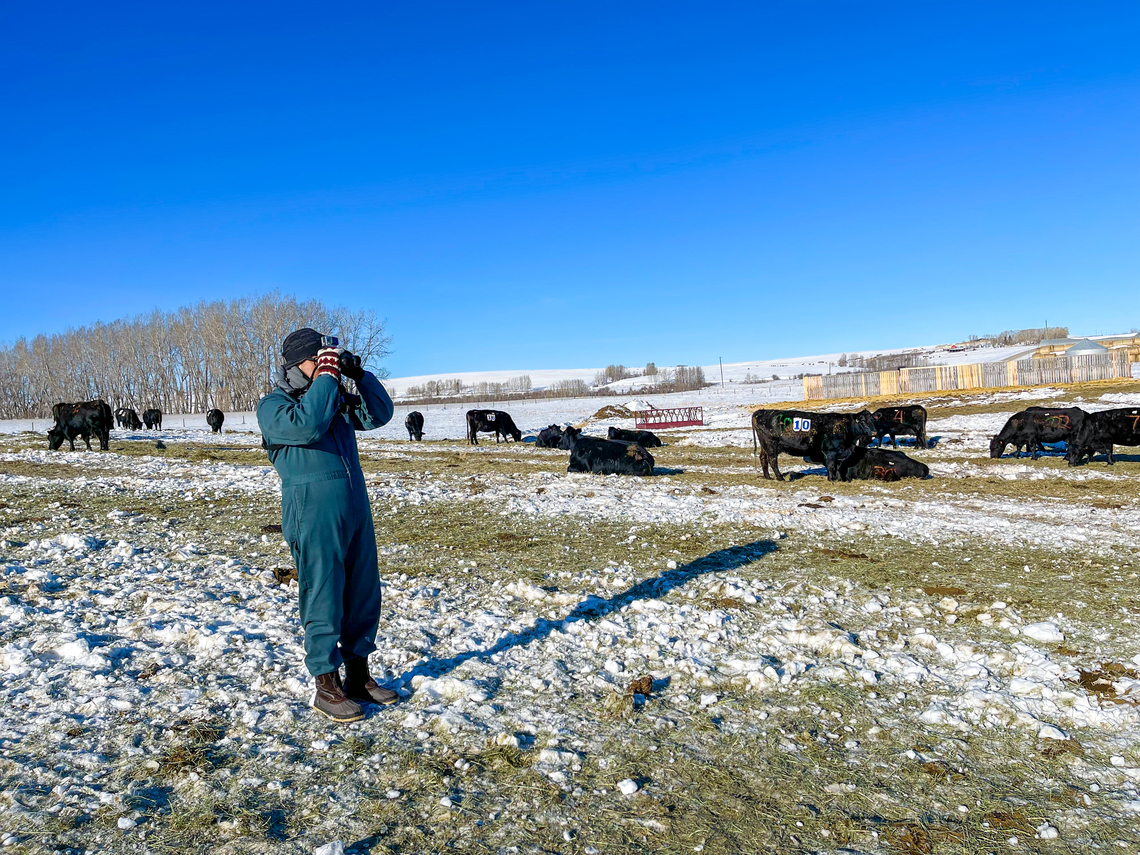
It is crucial to recognize that dams may respond differently to weaning compared to calves, as weaning stress may be perceived differently. Therefore, careful consideration is needed when selecting the best weaning method based on specific objectives and production goals.
The faculty at UCVM is continuing their research to assess the implications of weaning stress on the health, reproduction, and performance of dams and their offsprings in-utero, including replacement heifer, thereby ensuring optimized animal welfare and production practices.

Calving difficulty can be costly for Western Canadian cow-calf operations
Cecilia Lucio Rodriguez, Claire Windeyer, Kathy Larson, Ed Pajor, Jennifer Pearson
A recently graduated master’s student, Cecilia Lucio Rodriguez, investigated the cost of calving difficulty on western Canadian cow-calf operations. She surveyed cow-calf producers to create a time-budget of labour associated with calving assistance and utilized historical records of individual-animal production measures from 2015-2020 and industry-described inputs to create a modified decision tree model to estimate the cost, revenue, and profit associated with dam parity and calving assistance.
The average amount of time spent by ranch personnel assisting a calving was 15 minutes, while for c-sections, (performed by a veterinarian but needing assistance from the ranch personnel), it was 2 hours. From the cow-calf operations herd records, the incidence of assisted calvings in heifers was 4% and in cows was 2%.
Unassisted heifers had an expected loss of profit of -$76.11 and assisted heifers had an expected loss of profit of -$227.43 with a difference of -$151.32 CAD. Unassisted cows had an expected profit of $120.12 per calving and assisted cows had an expected loss of profit of -$67.06 per calving, with a difference of $187.18 CAD. The majority of costs associated with these financial losses were from calves born dead or dying shortly after calving (stillbirths), and loss of the cow either due to death associated with calving difficulty or being culled.
This research describes how costly calving assistance can be and how it may impact the profitability of western Canadian cow-calf operations. The results from this study can be used to make economic and management decisions with the objective to increase the health, welfare, and profitability of beef cattle.
Advancing Wildlife Conservation Through Drone Technology
Mapping Human and Wildlife Footprints in Northern Alberta’s Boreal Ecosystems
Greg McDermid, Irina Terenteva, Xue Yan Chan

The Boreal Ecosystem Recovery and Assessment (BERA) team from the University of Calgary conducted a field study at W.A. Ranches to advance human and wildlife footprint mapping. Researchers Greg McDermid, Xue Yan Chan, and Irina Terenteva used drone technology to collect high-resolution LiDAR and RGB data. Their focus was on evaluating wildlife trail visibility under winter conditions in both peatlands and dense forests. A significant outcome was obtaining thermal imagery, providing a distinct, real-time perspective of both animal and human movements. This study aims to refine mapping techniques and enhance our understanding of human impacts on wildlife, supporting improved conservation strategies in Northern Alberta.
Understanding the impacts of agricultural land use on wild rodent communities and their diseases
Laura Budd & Mathieu Pruvot
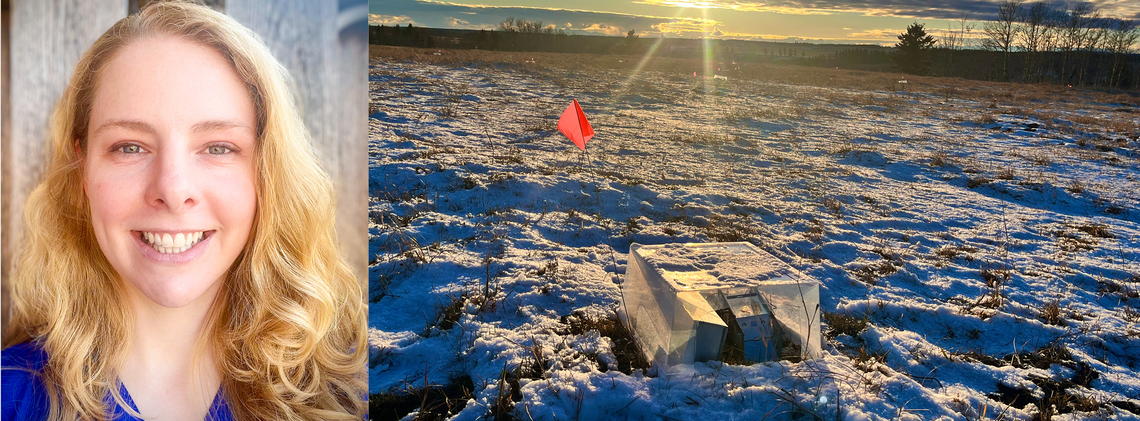
Preventing or reducing the impacts of infectious wildlife disease is important for preventing disease spillover that can lead to global human pandemics, reduce threats to livestock production, such as cattle in Alberta, and for maintaining healthy wildlife populations. The goal of our research is to understand how different agricultural practices impact the integrity of wild rodent communities and their diseases in Alberta’s grasslands.
We will compare different agricultural land-uses that can be found on W.A Ranches, such as cereal crops, cover crops, native prairie grass, forest patches, and around barns and other buildings. We will repeatedly trap wild rodents in each land-use type so we can compare the diversity and abundance of rodent species and obtain biological samples to characterize the diversity of their pathogens as well as their stress and immune responses.
We hope to learn if and how wild rodent populations differ between types of agricultural land-use and if that translates into differences in the pathogens present as well. We’ll explore if and how these change across seasons and different ranch activities throughout the year.
Ultimately, our goal is to develop a long-term monitoring program from which we can answer many questions regarding if and why certain agricultural practices may increase or decrease disease risk at the wild rodent-livestock-human interface. This may ultimately include assessing differences in access to food, water, and shelter in different pastures over time, the impact of different grazing regimes, differences in rodent physiology such as stress and immune function, differences in rodent space use and overlap, and ultimately how these influences the risk of disease spillover to or from rodents.
Our work will generate information on the effects of different agricultural land-uses and practices on the health and diseases of wildlife species and risk of spillover to livestock or people. This information can guide the inclusion of land management for health promotion and disease reduction as part of sustainable agriculture planning specific to Alberta.
Social Lives of Coyotes
Shelley M. Alexander
This research compiles wildlife data from a select portion of W.A. Ranches (2020-present) using wildlife cameras, field tracking, and coyote engagements to understand activity patterns and adaptability to human disturbance. Thousands of images from W.A. Ranches, Spy Hill, and Main U of C campuses are combined. A defended thesis by Robert Mitchell (Dec 2023) compared adult coyote behaviors. A separate manuscript on lifecycle behaviors in urban coyotes is under review (2024: Alexander, Draper & Paquet). Funding from NSERC, SSHRC, UC-VPR Office, and One-Health supported this research. Student volunteers like Stephen Shikaze (U of C Vet Med) at Spy Hill were vital for data collection.

Update: Preventing SARS-CoV2 reservoirs
Mathieu Pruvot, Shelley M. Alexander, Frank van der Meer, and Sabine Gilch
Funded by a UCalgary VPR Catalyst grant, our interdisciplinary team emphasizes One-Health concerns at human-wildlife interfaces. Steven Shikaze (UCVM) and MSc. Candidate Amanda Dickson (U of C Geography) collected 237 wildlife fecal samples across various sites, including urban, peri-urban (Calgary), and rural locations like W.A. Ranches.
While results were negative within our samples wildlife population, this does not preclude the risks of COVID-spillover from humans into wildlife; there is evidence several wild species have been infected in North America.
We built relationships across University of Calgary faculties and government agencies, and our samples were pooled into ongoing Canada wide spill-over research. Steven Shikaze will be writing up results on existing study before heading off to his internship.
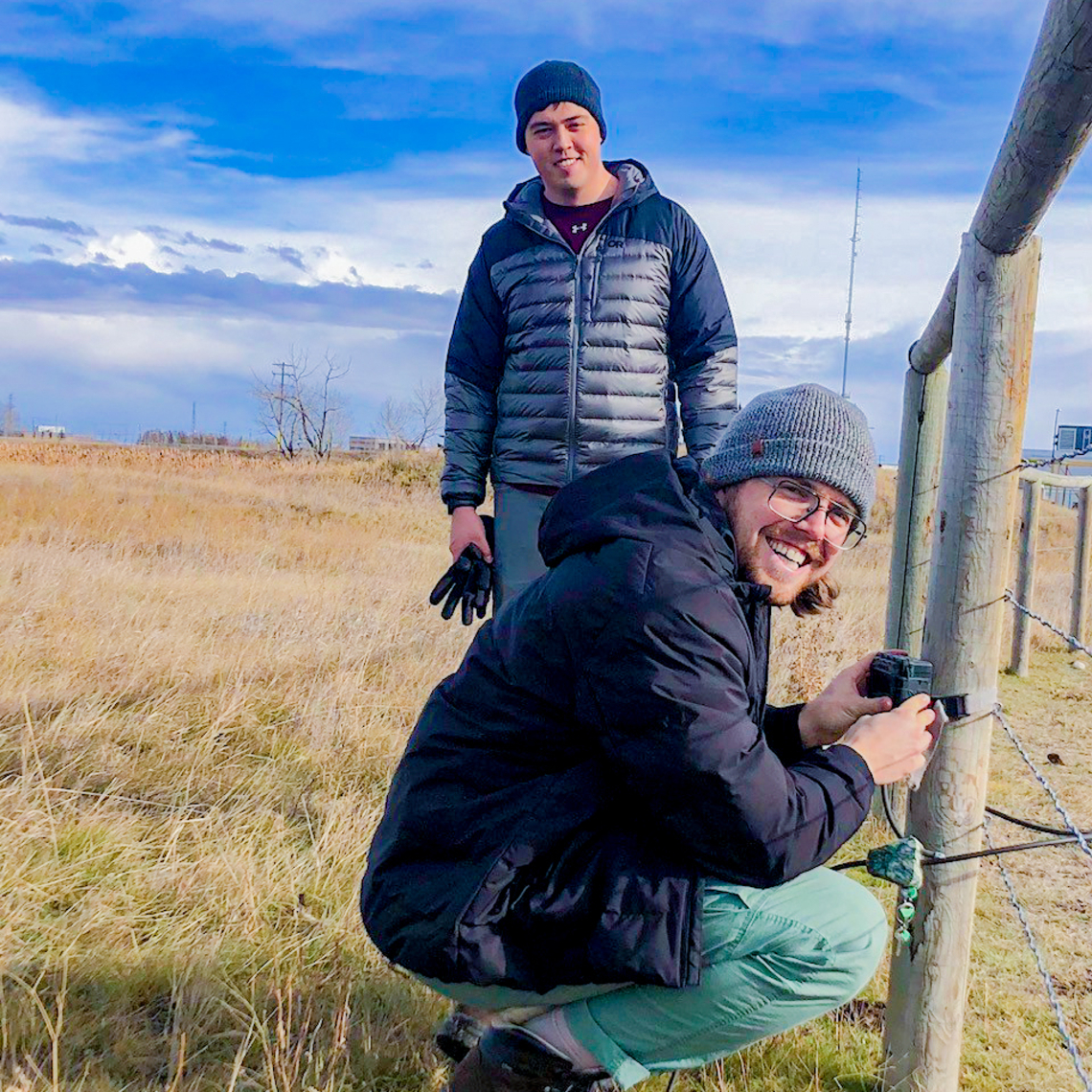
Radon in Alberta Groundwater
Evangeline Louise Eldridge

Radon exposure indoors is the top cause of lung cancer for folks who don’t smoke. While many studies have looked at where radon might show up based on rock types, not many have checked out if water from wells could add to the problem.
So, this research wanted to see how much groundwater contributes by comparing radon levels in homes with different water sources, figuring out where radon hangs out in Alberta’s water, and seeing what factors affect its presence.
They found that homes relying on well water had higher radon levels indoors (with an average of 137.0 Bq/m3) compared to those using surface water (with an average of 104.1 Bq/m3). They also checked radon levels in groundwater from 40 wells in different types of rock (which ranged from 0.20 to 75.1 Bq/L, averaging 8.1 Bq/L). Luckily, these levels were mostly below what’s considered risky for household water.
They noticed that radon levels didn’t really match up with any particular type of groundwater or how it changes chemically. There were some connections, though, like radon being less where there’s more methane in the water. This suggests that methane might be pulling radon out of the water in certain areas. Also, areas with less oxygen in the water had more radon, which lines up with lower levels of sulphate and uranium.
In short, radon in groundwater doesn’t seem to come from the rocks it flows through. Instead, it might hitch a ride with methane bubbles. This study helps us understand how radon moves and where it’s more likely to show up indoors. Click for full article
Congratulations to recent graduates that involved W.A. Ranches in their graduate work
Thesis title: Calf and human perspectives about handling and restraint during western Canadian beef calf processing events.
Thesis title: Effects of tactile stimulation and application of umbilical antiseptic on pre-weaned beef calf welfare.
Thesis title: The economic impacts of calving interventions and effects of a non-steroidal anti- inflammatory drug on behaviour and physiology of beef cows and calves assisted at calving.
Information on these and other beef related research projects can be found at:
From Pasture to Headlines: W.A. Ranches making news
Ask the Vet
With Dr. Ed Pajor
Ask the Vet
With Dr. Jennifer Pearson
Beefresearch.ca: Early Calf Life Survival
AG Discovery Day 2
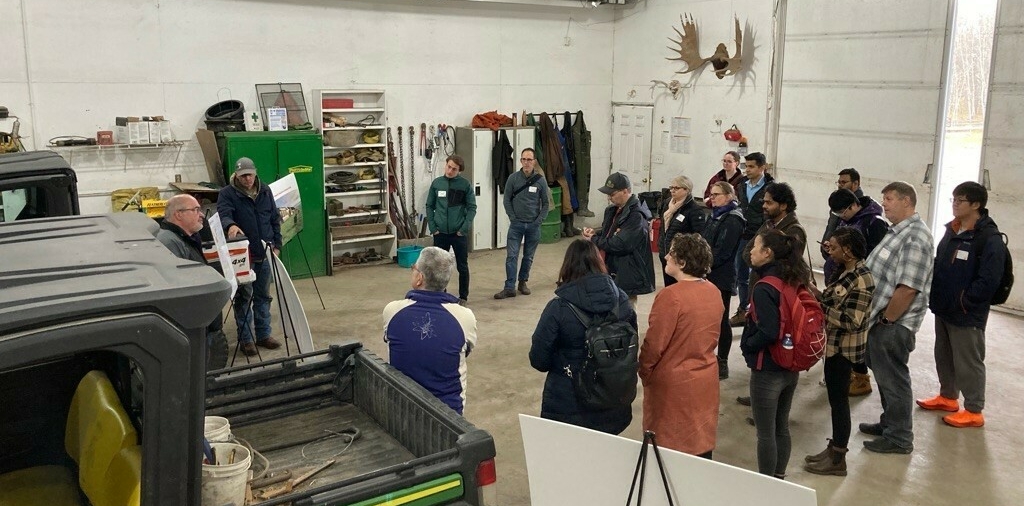
A Tour of W.A. Ranches was offered at the first “Ag Discovery Day” which was held at the Spy Hill campus on January 25, 2023 and was attended by different faculties, associate deans of research and deans across the UCalgary community. The first Ag Discovery Day’s goal was to create knowledge and understanding of what UCVM has to offer and to spark conversation surrounding how transdisciplinary work and research can become easier to access. The initial event had a speed dating format of three people per table for 10 minutes. From feedback received during this inaugural experience was that there is interest in staying connected and do it again. The event was perceived as very useful in making new connections and a tour of W.A. Ranches along with discussions about opportunities there was highlighted as an area of interest and curiosity.
In attendance for Ag Discovery Day 2, the UCalgary Faculty of Science was rather well represented. Sadly, engineering was unable to attend this time, but we plan to do this again in the future.
Dr. Karin Orsel, DVM, Faculty of Veterinary Medicine Professor, Epidemiology, Infectious Diseases of Cattle provided some background on the bus with everyone attending about the gift of W.A. and the general goal of the ranch. She pointed out the landscape to be able to work in, distance from main campus/city limited etc.
Upon arrival, Dr. Ed Pajor and Jonny Bennett provided an overview of the ranch and ranch management in the machine shop. The group walked up the hill to the calving shed to provide people with a feel for the land and facilities. After, the group traveled to Cochrane North to highlight the opportunities of cattle handling and cattle access. Many questions arose about crop land, cover crop, water wells etc. and interest in the procedures required to access W.A. resources.
This well received UCVM signature event will develop into a part of the fabric of the overall working and collaborating relationship with other faculties at UCalgary. The next event of this calibre, we will be passing the torch and will be hosted at another faculty’s area on campus. UCVM and W.A. Ranches will be there to contribute our message, ideas and resources to our fellow UCalgary community in hopes of building strong and lasting relationships within the UCalgary family for decades to come.
Canadian Ag transparency on display at IFAJ
From June 27 to July 3, the Canadian Farm Writers’ Federation hosted the International Federation of Agriculture Journalists conference in the Calgary area. Over 225 journalists from around the globe travelled to learn about transparency and trust in Canada’s agriculture industry directly from farm producers and select agribusinesses.
The University of Calgary School of Veterinary medicine (UCVM) hosted one of the 16 farm tours that were held during that week. Journalists on this tour, titled ‘Caring for Livestock’, spent the afternoon at UCVM learning about the school, W.A. Ranches, and the challenges facing the veterinarian industry.
The following images are from Quebec journalist Marie-Josée Parent. She participated on this tour and attended IFAJ 2023 thanks to a grant awarded by the Association of Agri-Food Communicators and Editors. Her story titled “Solution albertaine à la pénurie de vétérinaires” (Alberta solution to veterinarian shortage) first appeared in le Bulletin des agriculteurs on July 21, 2023 and can be found here.
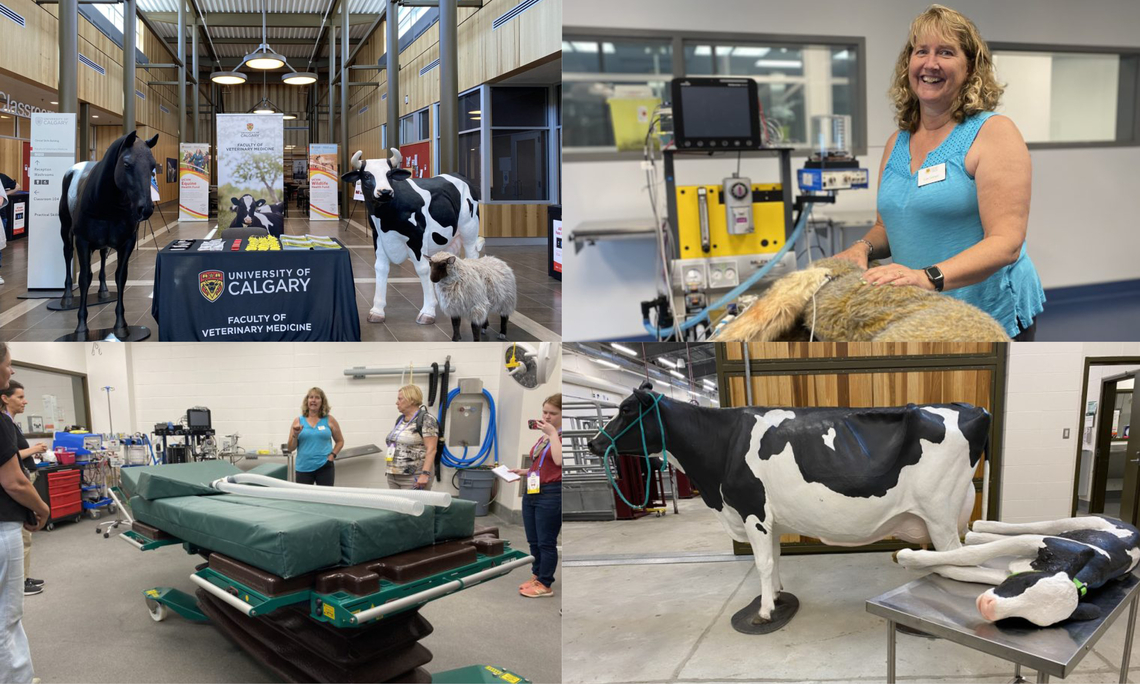
Youth Program Update
The youth program at W.A. Ranches made significant strides in 2023. The team said farewell earlier in the year to Robyn Kurbel who joined the faculty in October 2021 as the W.A. Ranches Youth Program Coordinator. Following in the great trail she blazed, Heather Mitchell-Matheson joined the team in June 2023 as the W.A. Ranches and UCVM Community Engagement and Outreach Coordinator.
The online Beef Cattle Health & Welfare Youth Certificate Program continued to gain momentum as the course saw more registrations and completions. The program’s eight modules remained highly beneficial for participants, preparing them for onsite, hands-on clinics designed to complement and enhance their online learning experience.
In early November 2023 we hosted another successful in person youth cattle handling workshop at W.A. Ranches, attended by 23 youth between the ages of 12 and 18. A sincere thanks again to Dr. Maria Camila Ceballos-Betancourt and her two graduate students for volunteering their time to help run the successful event. One parent contacted us afterwards sharing “We want to say thank you for the team putting on such an excellent program! The kids have not stopped raving about it!” so much in fact their daughter (from the Leduc area) wrote an article as the local 4-H reporter about the impactful experience.

In late February 2024 we hosted our second calving and calf health workshop at the UCVM Spy Hill campus, with 15 youth participants. At this workshop everyone was able to experience different scenarios pertaining to normal and abnormal calving situations. Sincere thanks again to Dr. Claire Windeyer, Dr. Jennifer Pearson and PhD candidate Dr. Vinicius Camargo for volunteering their time to help run this wildly popular event. One youth participant shared “My favourite part was getting to use the calving simulators, it helped me understand what to do, how to do it and help me get a feel for it”.
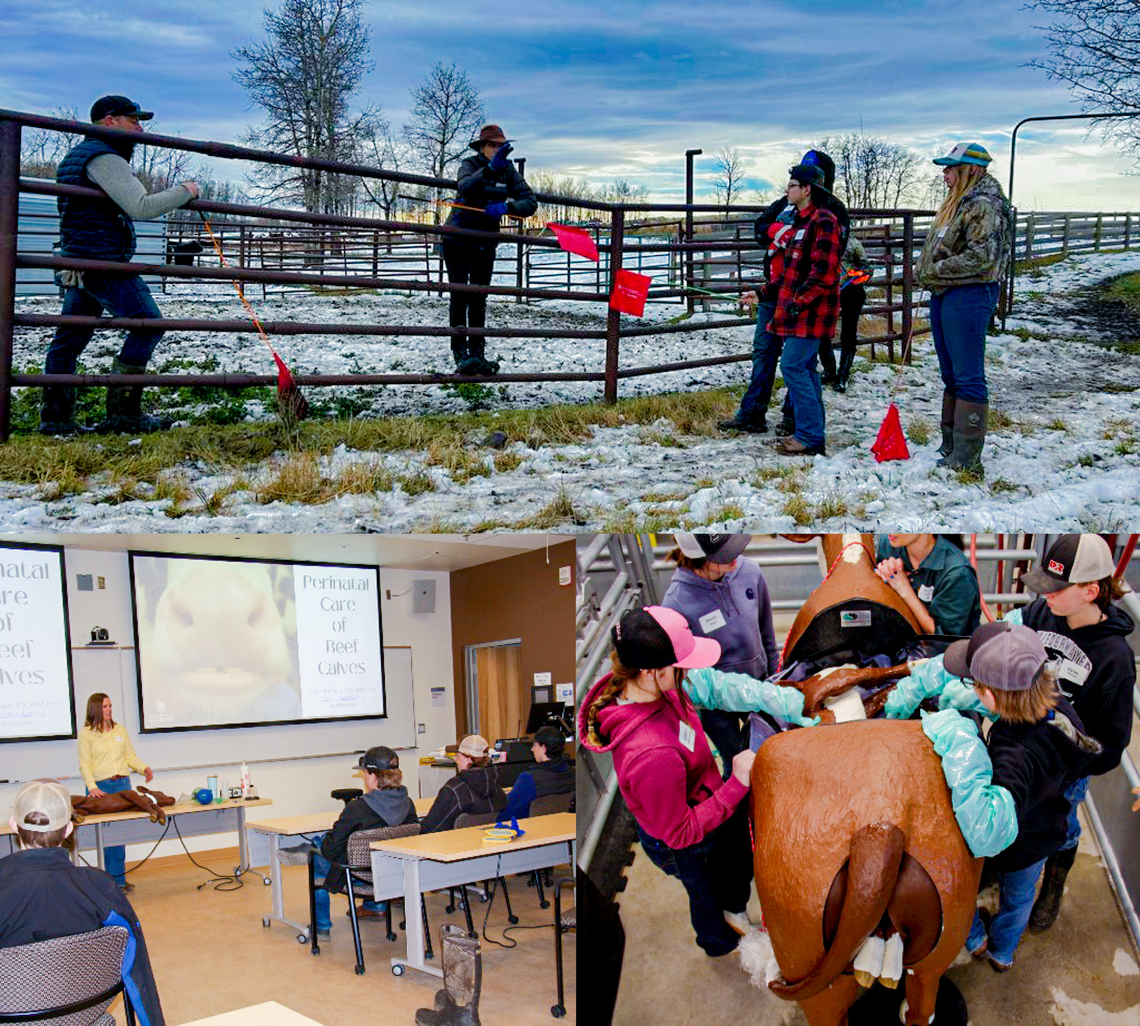
The beginning of March 2024 saw the realization of the third youth workshop in the series. The bovine lameness, vaccine and injections on-site workshop was also held at the UCVM Spy Hill campus. 19 youth engaged in exploring and identifying bovine lameness, situations that cause lameness as well as critically looking at limb anatomy of cattle. The hands-on experience included vaccine and injection best practices. A genuine thank you to Dr. Karin Orsel, Dr. Bruce Stover, Dr. John Remnant and three graduate students for volunteering their time to help run this inaugural experience. A parent sent this feedback afterwards “I just wanted to say how much our daughter enjoyed the workshop and thank you and your team for all the hard work putting things like this on for the kids”.
Several participants have now accomplished completion of the entire online certificate program as well as the three corresponding clinics. We were very pleased to be able to recognise their efforts and are looking forward to having more youth complete this educational series. We are thankful for the support of the Canadian Cattle Foundation, which makes these valuable programs possible.
Future planning for youth programming is under way with the development of a second online certificate geared towards urban and rural youth. The course will focus on topics such as sustainable agriculture, the future of technology in beef production and explore career opportunities in the vast beef sector. Stay tuned for more information on this exciting project as it’s developed.




